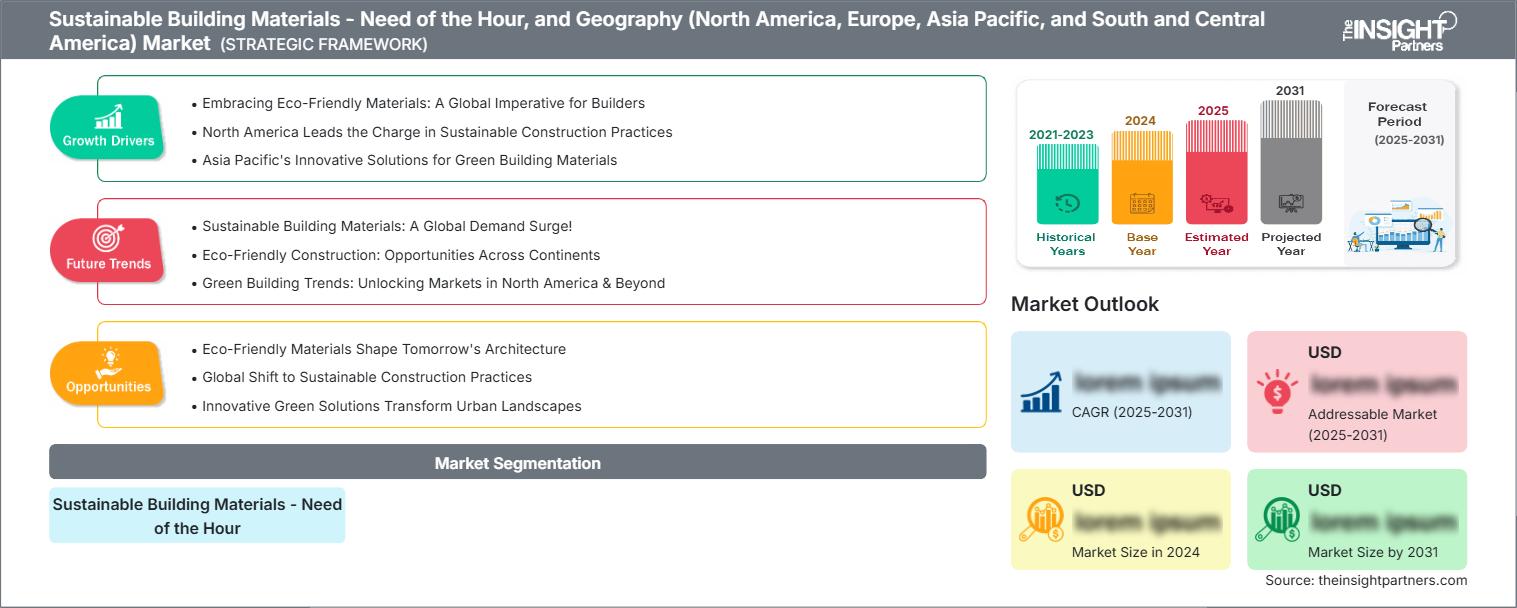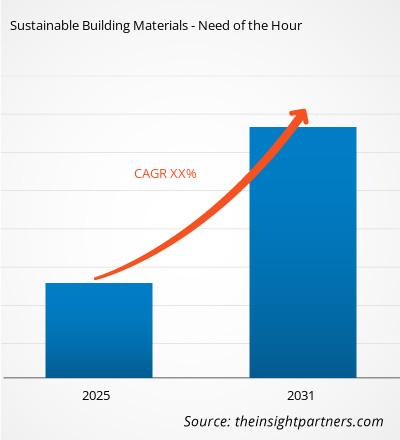건설은 대부분 국가에서 사회경제적 발전에 크게 기여하며, 에너지 소비의 대부분을 차지합니다. 건축 및 건설은 상당한 온실가스 배출을 유발하기 때문에 더욱 지속가능한 건축 공법을 요구하고 있습니다. 이러한 이유로 지속가능한 건축 자재는 세계 건설 산업에서 중요성을 더해가고 있습니다. 지속가능한 건축 자재는 에너지 효율과 내구성을 갖춘 친환경 건축 자재라고도 합니다. 지속가능한 건축 자재는 건물 수명 주기 전반에 걸쳐 쾌적하고 건강한 환경 조건을 조성하는 데 도움을 줍니다. 지속가능한 건축 자재의 주요 목표는 에너지, 물, 원자재를 효율적으로 사용하고 건물 환경에 미치는 영향을 최소화하는 것입니다. 그러나 지속가능성 구현의 복잡성과 산업의 분화로 인해 지속가능한 건축 자재의 구현 수준은 아직 초기 단계에 머물러 있습니다.
이 보고서의 일부 또는 국가 수준 분석, Excel 데이터 팩을 포함하여 모든 보고서에 대한 사용자 정의를 무료로 받을 수 있으며, 스타트업 및 대학을 위한 훌륭한 혜택과 할인도 이용할 수 있습니다.
지속 가능한 건축 자재 - 시대의 요구와 지역(북미, 유럽, 아시아 태평양, 남미 및 중미) 시장: 전략적 통찰력

-
이 보고서의 주요 시장 동향을 알아보세요.이 무료 샘플에는 시장 동향부터 추정치 및 예측까지 다양한 데이터 분석이 포함됩니다.
건설 부문의 발전으로 지속가능한 도시와 인프라에 대한 수요가 증가함에 따라 지속가능한 건축자재 시장이 활성화될 것으로 예상됩니다. 대형 건설사들은 재정적, 환경적 비용을 절감하면서 인증받은 지속가능한 건물을 공급하고자 합니다. 미국에서는 그린빌딩협의회(Green Building Council)의 에너지 및 환경 디자인 리더십(LEED) 제도가 건축자재 및 제품의 제조 단계부터 수명 종료 단계까지 인증 절차에서 역할을 확장하는 새로운 방식을 도입했습니다. 대부분의 산업에서 디지털화와 자동화가 도입됨에 따라, 건설 산업은 디지털 기술과 첨단 자동화를 건물 및 인프라에 통합하여 혁신을 이룰 수 있습니다. 건축 환경에서 발생하는 고형 폐기물의 30~40%가 지속가능한 건축자재로 발생함에 따라, 지속가능한 건축자재는 건설 산업에 비용 절감, 자원 보존, 환경 보호라는 중요한 기회를 제공합니다. 지속가능한 건축자재로 사용되는 주요 자재로는 친환경 단열재, 재활용 금속, 재생 목재, 대나무, 단열 발포 콘크리트, 재활용 유리 등이 있습니다. 이러한 자재는 친환경 자재로 생산, 시공 및 유지 관리 과정에서 환경에 미치는 영향이 적습니다. 대부분 재활용 가능하며 현지에서 조달되는 자재입니다. 기업들은 지속가능한 건축 자재를 사용하여 탄소 제로 건물을 추구하고 건축 주기의 성능을 최적화하고 있습니다. 시장에는 지속적으로 친환경 자재가 출시되고 있으며, 이를 통해 주택 및 상업 건축의 에너지 비용이 크게 절감됩니다.
지속 가능한 건축 자재 - 시대의 요구와 지리적 위치(북미, 유럽, 아시아 태평양, 남미 및 중미) 시장 지역 통찰력
The Insight Partners의 분석가들은 예측 기간 동안 지속 가능한 건축 자재 - 시급한 요구, 지역(북미, 유럽, 아시아 태평양, 중남미) 시장에 영향을 미치는 지역별 동향과 요인을 면밀히 분석했습니다. 이 섹션에서는 북미, 유럽, 아시아 태평양, 중동 및 아프리카, 중남미 지역의 지속 가능한 건축 자재 - 시급한 요구, 지역(북미, 유럽, 아시아 태평양, 중남미) 시장 부문 및 지역별 현황도 다룹니다.
지속 가능한 건축 자재 - 시대의 요구 및 지역(북미, 유럽, 아시아 태평양, 남미 및 중미) 시장 보고서 범위
| 보고서 속성 | 세부 |
|---|---|
| 2024년 시장 규모 | 미화 XX백만 달러 |
| 2031년까지 시장 규모 | 미화 XX백만 달러 |
| 글로벌 CAGR(2025~2031년) | 더블 엑스% |
| 역사적 데이터 | 2021-2023 |
| 예측 기간 | 2025-2031 |
| 다루는 세그먼트 | 지속 가능한 건축 자재 - 시대의 요구 |
| 포함된 지역 및 국가 |
북아메리카
|
| 시장 선도 기업 및 주요 회사 프로필 |
|
지속 가능한 건축 자재 - 시대의 요구와 지리적 위치(북미, 유럽, 아시아 태평양, 남미 및 중미) 시장 참여자 밀도: 비즈니스 역학에 미치는 영향 이해
지속 가능한 건축 자재 - 시대적 요구 및 지역(북미, 유럽, 아시아 태평양, 중남미) 시장은 소비자 선호도 변화, 기술 발전, 그리고 제품의 이점에 대한 인식 제고 등의 요인으로 인한 최종 사용자 수요 증가에 힘입어 빠르게 성장하고 있습니다. 수요가 증가함에 따라 기업들은 제품 라인업을 확장하고, 소비자 요구를 충족하기 위한 혁신을 추진하며, 새로운 트렌드를 적극 활용하고 있으며, 이는 시장 성장을 더욱 가속화하고 있습니다.

- 지속 가능한 건축 자재 - 시대의 요구 사항 및 지리(북미, 유럽, 아시아 태평양, 남미 및 중미) 시장 주요 주요 업체 개요를 확인하세요.
북미와 유럽은 친환경 또는 지속 가능한 건축 자재의 주요 사용자입니다. 건설 회사의 절반 이상이 프로젝트에 친환경 건축을 도입했습니다. 그러나 인도와 같은 개발도상국은 지속 가능한 건물에 대한 인센티브가 부족합니다. 소비자들은 천천히 그리고 꾸준히 친환경 주택으로 이동하여 지속 가능한 건축 자재를 장려하고 있습니다. 인도에서는 친환경 건축법(Green Building Code)에 따라 주 조례 및 LEED-India, 인도 친환경 건축 위원회(IGBC), TERI-GRIHA 및 기타 인증과 같은 등급 프로그램에서 정한 규범에 규정과 표준이 명시되어 있습니다. 이러한 정책의 효과적인 시행과 상업 건설업체가 인센티브 형태의 세제 혜택과 신속한 허가를 받는 것이 중요합니다.
건설의 영향은 수십 년 동안 지속되며 현재 세대뿐만 아니라 미래 세대에도 영향을 미칩니다. 따라서 건설 중 및 건물 수명 주기 이후에도 환경에 긍정적인 영향을 미치는 지속 가능한 건축 자재를 채택하는 것이 시급합니다.
- 과거 분석(2년), 기준 연도, CAGR을 포함한 예측(7년)
- PEST 및 SWOT 분석
- 시장 규모 가치/거래량 - 글로벌, 지역, 국가
- 산업 및 경쟁 환경
- Excel 데이터세트
최근 보고서
사용 후기
구매 이유
- 정보에 기반한 의사 결정
- 시장 역학 이해
- 경쟁 분석
- 고객 인사이트
- 시장 예측
- 위험 완화
- 전략 기획
- 투자 타당성 분석
- 신흥 시장 파악
- 마케팅 전략 강화
- 운영 효율성 향상
- 규제 동향에 발맞춰 대응






















 무료 샘플 받기 - 지속 가능한 건축 자재 - 시대의 요구와 지리(북미, 유럽, 아시아 태평양, 남미 및 중미)
무료 샘플 받기 - 지속 가능한 건축 자재 - 시대의 요구와 지리(북미, 유럽, 아시아 태평양, 남미 및 중미)